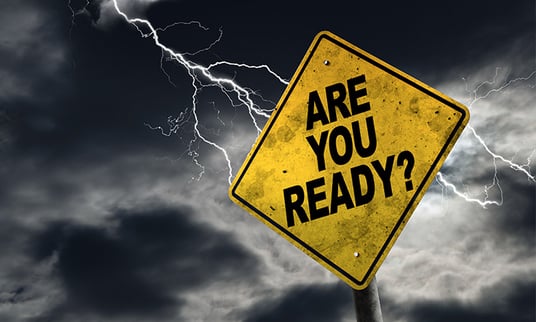
By: Bob Baumann
Natural disasters are often a reality check for many commercial businesses and their facilities, costing thousands of dollars in lost assets and emergency maintenance services. [bctt tweet=”A FEMA report showed that between 2011 to 2015, the average commercial flood claim was just under $90,000.” username=”enternest”] If recent hurricanes have prompted you to react, now is the best time to get a business continuity plan in place. Waiting to plan will only put your business and assets at a greater risk.
While you can’t make your facilities disaster-proof, you can minimize the financial impact of hurricane and flood damage by being proactive. Preparation is cheaper than reacting after the fact and can mean the difference between promptly reopening your doors or being closed for weeks.
Proactive planning for natural disasters allows you to:
- Act quickly
- Prevent loss
- Better control costs
- Reduce operational stress
If preparedness is your goal, follow this advice for best practice disaster recovery planning.
- Disaster Preparation Starts With Facility Layout and Design
While looks are important for creating brand appeal, facility layouts designed primarily for aesthetic reasons can inadvertently lead to future high-dollar repairs and downtime. Preventative changes to your facilities can be made that are invisible to customers.
Consider the following to protect your assets from hurricanes and flooding:
- Raise fixtures 6” off the floor
- Keep cloth materials 8” off the floor
- Replace particle board fixture bases with marine grade plywood
- Raise all transformers and power boxes as high as building codes allow
- Use ceramic floor tiling instead of carpet or wood if your brand allows
- Use wall tile installed over cement board instead of sheetrock where possible
- Keep porous materials such as slatwall 8” above floor level
- Move electronics as high as possible (POS, phones, printers, etc.)
If you are located in a flood-prone area, the ROI of these preventative measures can save you thousands and get your store back to generating revenue much faster.
- Facility Code Compliance Matters
Is your facility up-to-date and code compliant? Issues such as faulty sprinklers systems or out-of-date fire extinguishers go against building safety codes and can prevent you from being eligible to claim insurance in the event of a disaster.
If you are not responsible for the design and build, verify with the developer or landlord what measures are being taken to make the facility disaster ready. If you are responsible for your building, run an audit for safety compliance issues and address them as soon as possible.
- Have Reaction and Disaster Recovery Service Agreements in Place
Hurricanes and floods can happen with little warning beforehand. If you find yourself preparing after you’ve heard the news, you could be in trouble. So, how far in advance should you prepare?
The longer you wait, the less prepared you will be. Your best option is to have facility service agreements in place at all times. Make sure you’ve opened communications with the following facility service providers prior to the storm:
- Product salvage
- General contractors
- Engineers
- Industrial Hygienist
- Public relations
You’ll want to predefine a base scope of work to be performed for your first response services. Include expected tasks such as water extraction and the setup of dehumidifiers and air movers which should be started on your behalf until further situational information is gathered. Allowing maintenance providers to take action immediately is key for recovering assets, reopening your doors, and getting back to business.
- Get Organized and Take Inventory
Now’s the time to get your act together. Before closing your doors for an impending storm, you’ll want to take a physical inventory of all products, backup any critical electronic data, and deposit all cash in the bank.
One thing you have to stay mindful of is that local employees will also have their own disaster at home to deal with and may not be available to respond to an emergency at the store. Make sure you have updated contact information for your employees and identify who will be available if needed.
For retailers in heavily saturated market areas, consider purchasing raw materials in bulk ahead of time. If you’re caught unprepared in the wake of a severe storm, you’ll find yourself competing for service resources with other affected businesses.
Lastly, you’ll want to confirm that your maintenance contractors will be ready to respond once the storm hits.
- When it Hits, Don’t React. Respond!
The pressure is on to get the store open as soon as the storm clears. Your goal should be to convert your store from a negative expense to a profit center ASAP! If a potential hurricane or flood is in your forecast, you need to have a responsible facility manager available to communicate, execute, and monitor your disaster recovery plan (DRP).
Whoever is responsible will want to get in touch with your maintenance providers to ensure first response services have begun. At this point, it needs to be determined what further actions are necessary. Depending on the severity of flooding or other damages, you may need to move merchandise or fixtures and determine where to temporarily store displaced items. You may even be called on to make decisions about the building’s structure itself. In any case, make sure before approving any work that you review the scope verbally with the provider and ensure any “disclaimers” are spelled out.
Stay calm! Managing the aftermath of a natural disaster is stressful, so make sure you’re working in tandem with other retail colleagues involved. Make sure all progress is being documented and sent to the necessary parties. Photos and videos go a long way when claiming insurance. Once your plan is in place, don’t trip over dollars while trying to save dimes. Retailers that make quick decisions open much faster than those that don’t.
NEST Has Been Helping Companies Recover from Natural Disasters for More Than 20 Years!
In the wake of a disaster, having good relations with service providers goes a long way. Our ISP Network provides businesses with trusted maintenance providers that are on call, allowing facility managers to focus more on keeping their operations going. Our consulting services also allow us to help clients with project management and getting their facilities open in a timely manner.
Do you have any storm stories and how you handled them successfully?
Need help? We’re here for you.
To stay up-to-date, follow us on LinkedIn!







